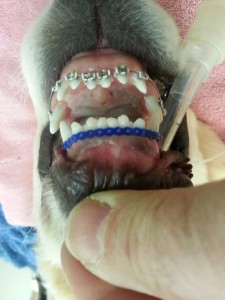Yes, this blog has officially gone to the dogs today!
According to nationaldogday.com, National Dog Day is celebrated August 26th annually and was founded in 2004 by Pet and Family Lifestyle Expert and Animal Advocate, Colleen Paige, also the founder of National Puppy Day, National Mutt Day and National Cat Day and many more philanthropic days to bring attention to the plight of animals and encourage adoption. The date of August 26th is significant, as it’s the date that Colleen’s family adopted her first dog “Sheltie” when Colleen was 10 years old.
Here at Horner Barrow Orthodontics, we wanted to pay tribute to our furry best friends by talking a little bit about braces for dogs.
We humans aren’t the only ones who can benefit from having our teeth straightened. It turns out that sometimes, man’s best friend’s bite needs to be corrected.
Since the 1980s, veterinary dentists have used braces and other orthodontic appliances to treat dogs with painful and potentially dangerous dental issues. Many of the tools, devices and orthodontic appliances used are borrowed from human orthodontics, but the end goal is completely different. It’s not for aesthetic reasons, but for a healthier, more comfortable bite.
Applying braces to a dog is not a task to be taken lightly. The dog should be healthy enough to undergo anesthesia, and able to tolerate repeated oral examinations, and poking and prodding as the treatment progresses. Dog owners also need to be vigilant about maintaining and cleaning their pet’s mouth throughout the orthodontic treatment process.
Braces for dogs is usually not the only option, but in some cases, it is the best option.
Issues That Require Dog Braces
Braces can help dogs who are dealing with everything from crowded teeth to cancer.
One of the most common issues dog braces are used to treat is a condition called linguoversion, when the teeth are pushed back towards the tongue. When the linguoversion occurs on the lower teeth, it’s called “base narrow.”
In this position, the teeth may rub against the roof of the dog’s mouth. At best, this can cause major discomfort. At worst, the teeth could poke holes in the roof of the mouth, leading to chronic and serious sinus infections.
Other conditions that can cause problems include overbite, when the lower jaw is shorter than the top, and lance teeth, when the upper canines point out rather than down.
Braces may also be used when a dog’s baby teeth fail to fall out properly. As the adult teeth come in, the mouth becomes more and more crowded, leading to a higher risk of infections.
In more extreme cases, braces may also be applied after part of the jaw has been removed for canine cancer treatment. Orthodontic treatment in these cases helps to minimize tooth drift.
It’s up to a veterinarian to determine whether the dog’s teeth are just crooked, or crooked and causing problems. They will not apply braces for cosmetic reasons.
Remember, the end treatment goal is not to give the dog a dazzling Hollywood smile, but to give the dog a mouth that’s healthy and functional.
Dr. Kevin Horner and Dr. Keri Barrow are only able to treat humans with orthodontic issues! Talk with your vet if you think your dog is having issues with his or her mouth.
If any of our Sioux Falls, SD patients have a dog that is also undergoing orthodontic treatment, we would love to see photos!
At Horner Barrow Orthodontics, we are committed to delivering excellent quality orthodontic treatment to each and every patient. To provide a friendly, caring, and pleasant atmosphere that will ensure our patients feel relaxed and confident about placing their orthodontic care in our hands.




